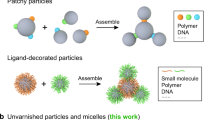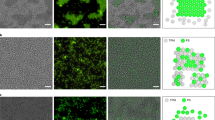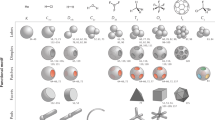Abstract
Particles with directional interactions are promising building blocks for new functional materials and may serve as models for biological structures1,2,3. Mutually attractive nanoparticles that are deformable owing to flexible surface groups, for example, may spontaneously order themselves into strings, sheets and large vesicles4,5,6. Furthermore, anisotropic colloids with attractive patches can self-assemble into open lattices and the colloidal equivalents of molecules and micelles7,8,9. However, model systems that combine mutual attraction, anisotropy and deformability have not yet been realized. Here we synthesize colloidal particles that combine these three characteristics and obtain self-assembled microcapsules. We propose that mutual attraction and deformability induce directional interactions via colloidal bond hybridization. Our particles contain both mutually attractive and repulsive surface groups that are flexible. Analogously to the simplest chemical bond—in which two isotropic orbitals hybridize into the molecular orbital of H2—these flexible groups redistribute on binding. Via colloidal bond hybridization, isotropic spheres self-assemble into planar monolayers, whereas anisotropic snowman-shaped particles self-assemble into hollow monolayer microcapsules. A modest change in the building blocks thus results in much greater complexity of the self-assembled structures. In other words, these relatively simple building blocks self-assemble into markedly more complex structures than do similar particles that are isotropic or non-deformable.
This is a preview of subscription content, access via your institution
Access options
Subscribe to this journal
Receive 51 print issues and online access
$199.00 per year
only $3.90 per issue
Buy this article
- Purchase on Springer Link
- Instant access to full article PDF
Prices may be subject to local taxes which are calculated during checkout




Similar content being viewed by others
References
Zhang, Z. & Glotzer, S. C. Self-assembly of patchy particles. Nano Lett. 4, 1407–1413 (2004)
Glotzer, S. C. & Solomon, M. J. Anisotropy of building blocks and their assembly into complex structures. Nature Mater. 6, 557–562 (2007)
Yi, G.-R., Pine, D. J. & Sacanna, S. Recent progress on patchy colloids and their self-assembly. J. Phys. Condens. Matter 25, 193101 (2013)
Akcora, P. et al. Anisotropic self-assembly of spherical polymer-grafted nanoparticles. Nature Mater. 8, 354–359 (2009)
Nikolic, M. S. et al. Micelle and vesicle formation of amphiphilic nanoparticles. Angew. Chem. Int. Ed. 48, 2752–2754 (2009)
Luiken, J. A. & Bolhuis, P. G. Anisotropic aggregation in a simple model of isotropically polymer-coated nanoparticles. Phys. Rev. E 88, 012303 (2013)
Chen, Q., Bae, S. C. & Granick, S. Directed self-assembly of a colloidal kagome lattice. Nature 469, 381–384 (2011)
Wang, Y. et al. Colloids with valence and specific directional bonding. Nature 491, 51–55 (2012)
Kraft, D. J. et al. Surface roughness directed self-assembly of patchy particles into colloidal micelles. Proc. Natl Acad. Sci. USA 109, 10787–10792 (2012)
Larson-Smith, K. & Pozzo, D. C. Scalable synthesis of self-assembling nanoparticle clusters based on controlled steric interactions. Soft Matter 7, 5339–5347 (2011)
Wang, P. H. & Pan, C.-Y. Preparation of styrene/acrylic acid copolymer microspheres: polymerization mechanism and carboxyl group distribution. Colloid Polym. Sci. 280, 152–159 (2002)
Hu, X., Liu, H., Ge, X., Yang, S. & Ge, X. Preparation of submicron-sized snowman-like polystyrene particles via radiation-induced seeded emulsion polymerization. Chem. Lett. 38, 854–855 (2009)
Bates, F. S. Polymer-polymer phase behavior. Science 251, 898–905 (1991)
Asai, M., Cacciuto, A. & Kumar, S. K. Quantitative analogy between polymer-grafted nanoparticles and patchy particles. Soft Matter 11, 793–797 (2015)
Geerts, N. & Eiser, E. Flying colloidal carpets. Soft Matter 6, 664–669 (2010)
Sheu, H. R., El-Aasser, M. S. & Vanderhoff, J. W. Uniform nonspherical latex particles as model interpenetrating polymer networks. J. Polym. Sci. A 28, 653–667 (1990)
Mock, E. B., De Bruyn, H., Hawkett, B. S., Gilbert, R. G. & Zukoski, C. F. Synthesis of anisotropic nanoparticles by seeded emulsion polymerization. Langmuir 22, 4037–4043 (2006)
Kraft, D. J., Groenewold, J. & Kegel, W. K. Colloidal molecules with well-controlled bond angles. Soft Matter 5, 3823 (2009)
Marchand-Brynaert, J., Deldime, M., Dupont, I., Dewez, J.-L. & Schneider, Y.-J. Surface functionalization of poly(ethylene terephthalate) film and membrane by controlled wet chemistry: chemical characterization of carboxylated surfaces. J. Colloid Interf. Sci. 173, 236–244 (1995)
Dinsmore, A. D. et al. Colloidosomes: selectively permeable capsules composed of colloidal particles. Science 298, 1006–1009 (2002)
Chen, T., Zhang, Z. & Glotzer, S. C. Simulation studies of the self-assembly of cone-shaped particles. Langmuir 23, 6598–6605 (2007)
Deegan, R. D. et al. Capillary flow as the cause of ring stains from dried liquid drops. Nature 389, 827–829 (1997)
Berg, J. M., Tymoczko, J. L. & Stryer, L. Biochemistry (ed. Stryler, L. ) (W. H. Freeman and Company, 2002)
Tompa, P. & Fuxreiter, M. Fuzzy complexes: polymorphism and structural disorder in protein–protein interactions. Trends Biochem. Sci. 33, 2–8 (2008)
Freund, S. M. V., Johnson, C. M., Jaulent, A. M. & Ferguson, N. Moving towards high-resolution descriptions of the molecular interactions and structural rearrangements of the human hepatitis B core protein. J. Mol. Biol. 384, 1301–1313 (2008)
Groschel, A. H. et al. Guided hierarchical co-assembly of soft patchy nanoparticles. Nature 503, 247–251 (2013)
Crassous, J. J. et al. Field-induced assembly of colloidal ellipsoids into well-defined microtubules. Nature Commun. 5, 5516 (2014)
van Ravensteijn, B. G. P., Kamp, M., van Blaaderen, A. & Kegel, W. K. General route toward chemically anisotropic colloids. Chem. Mater. 25, 4348–4353 (2013)
Asakura, S. & Oosawa, F. On interaction between two bodies immersed in a solution of macromolecules. J. Chem. Phys. 22, 1255 (1954)
Bhattacharyay, A. & Troisi, A. Self-assembly of sparsely distributed molecules: an efficient cluster algorithm. Chem. Phys. Lett. 458, 210–213 (2008)
Acknowledgements
We thank B. G. P. van Ravensteijn for providing non-deformable, fluorescein functionalized snowman-shaped particles, S. I. R. Castillo for taking the SEM images, and J. D. Meeldijk and C. T. W. M. Schneijdenberg for help with freeze drying and TEM. This work is part of the research programmes VICI 700.58.442 and TOP-GO 700.10.355, which are financed by the Netherlands Organization for Scientific Research. We thank A. van Blaaderen and M. Dijkstra for discussions, and M. de Jong for reading the manuscript.
Author information
Authors and Affiliations
Contributions
All authors designed the research; C.H.J.E. synthesized the particles and analysed the self-assembled structures; J.A.L. performed and analysed the Monte Carlo simulations. W.K.K. and P.G.B. supervised the project. All authors discussed the results and implications and wrote the paper.
Corresponding authors
Ethics declarations
Competing interests
The authors declare no competing financial interests.
Extended data figures and tables
Extended Data Figure 1 pH-induced structural rearrangements.
a, For poly(styrene-co-acrylic acid) spheres with a TEM diameter d = 0.530 ± 0.014 μm, the apparent hydrodynamic diameter, dhd, is measured using dynamic light scattering. At ionic strength I ≈ 1 mM, dhd equals 0.79 μm at pH 10, but decreases to 0.57 μm at pH 3 (blue). On screening electrostatic interactions at I ≈ 10 mM (red), or for polystyrene spheres without acrylic acid (green), however, the measured diameter remains almost constant with pH. We conclude that at high pH, the electrostatic repulsion between acrylic acid groups triggers the poly(acrylic acid)-rich brush to expand by about 0.1 μm into the solution. b, The measured polydispersity index, PdI, stays constant, indicating that changing the pH does not induce aggregation.
Extended Data Figure 2 Synthesis.
a–g, Schematic outline (a) and microscopy images (b–g) of the synthesis of mutually attractive, anisotropic, deformable particles. Poly(styrene-co-acrylic acid) spheres (b, c, TEM) with a hydrophobic core (red in a) and a deformable brush (blue in a) are swollen with monomer, heated, and polymerized, resulting in snowman-like particles (d, e, TEM) with a deformable lobe and a rigid protrusion (green in a). Hydrophobic molecules (yellow in a) are covalently linked to the acrylic acid groups, resulting in fluorescent particles when fluoresceinamine is used (f, g, fluorescence microscopy).
Extended Data Figure 3 SEM images of self-assembled microcapsules.
To prevent disintegration upon drying, microcapsules are studied after sintering (a–e) or freeze-drying (f–j). During sintering, the solvent (light blue) is heated in order to partly merge the particles (red) (a, b). During freeze-drying, vitrified water (dark blue) is sublimated under vacuum (f, g). Particles in the microcapsules have six (blue asterisks) or five (green squares) neighbours, and both protrusions that point slightly inwards (red circles) and outwards (light red triangles) are found (d, i). Besides microcapsules, also planar monolayers (j) are observed.
Extended Data Figure 4 Formation of microcapsules and cavities on varying the complexity of the particles.
a–d, The complexity of particles (a) that are deformable (blue), anisotropic (green) and functionalized with mutually attractive groups (yellow) is varied, resulting in non-functionalized particles (b), isotropic particles (c) and non-deformable particles (d). Microcapsules are only found in the first case. e–v, All particles are studied using bright field microscopy at the edge of an evaporating droplet (e–h), in a sediment after centrifugation (i–p), and upon diluting the sediment (q–v). The entire images of e–h can be found in Extended Data Fig. 6 and magnifications of i–k can be found in Extended Data Fig. 7b–d. The arrows indicate the directions of the particle flow,  , or the gravitational field,
, or the gravitational field,  .
.
Extended Data Figure 5 Monolayer sheets.
For mutually attractive, anisotropic, deformable particles with varying sizes (a–c), not only hollow microcapsules (Fig. 2), but also two-dimensional hexagonal planar monolayers (e–g) are observed using bright field microscopy. Both fluoresceinamine (a–c, e–g) and tert-butylamine (d, h) are used as hydrophobic moieties and for both moieties monolayers are observed.
Extended Data Figure 6 Formation of cavities at the contact line.
The complexity of mutually attractive, anisotropic, deformable particles (a–d) is varied resulting in non-functionalized particles (e–h), isotropic particles (i–l) and non-deformable particles (m, n). For each particle type, part of the contact line of an evaporating droplet is studied four times (twice for non-deformable particles). Many cavities are found for mutually attractive, anisotropic, deformable particles (red arrows), whereas for isotropic particles many fewer cavities are found and the other particles did not show any cavities. Crops of these images can be found in Extended Data Fig. 4. The white arrows indicate the direction  .
.
Extended Data Figure 7 Centrifuged sediments.
Magnifications of the bright field microscopy images in Fig. 3r (a) and Extended Data Fig. 4i–k (b–d). a–d, For mutually attractive, anisotropic, deformable particles, spherical cavities are observed in the sediment (a, b), whereas the sediments of similar non-functionalized and isotropic particles show no (c) and fewer (d) cavities.
Extended Data Figure 8 Clusters of isotropic particles.
a, b, Morphology diagrams of mutually attractive, isotropic, deformable particles as a function of the dimensionless diameter of the satellite spheres, q, and the number of satellite spheres, f. c–k, Representative snapshots with cores (red) and satellite spheres (blue). a, When unbound particles are used as the initial configuration and q and f are increased, compact (c, open circles), cylindrical (d, open triangles), flattened (e, filled circles), rod-like (f, asterisks) and finite-size (g, open squares) clusters as well as unbound particles (h, filled triangles) are found. b, When the initial configuration is a hexagonal monolayer, compact clusters (i, open circles), bilayers (j, open diamonds) and monolayers (k, crosses) are observed. The transitions between different morphologies are parallel to isolines for the covered surface fraction, Q = 0.1 to 0.5 (dashed lines in a and b).
Extended Data Figure 9 Clusters of anisotropic particles.
a, b, Morphology diagrams of clusters of mutually attractive, anisotropic, deformable particles as a function of the dimensionless diameter of the satellite spheres, q, and the number of satellite spheres, f. c–n, Representative snapshots with cores (red), protrusions (green) and satellite spheres (blue). a, When unbound particles are used as the initial configuration, increasing f and q results in compact (c, open circles), cylindrical (d, open triangles), rod-like (e, asterisks), flattened (f, filled circles) and finite-size (g, open squares) clusters as well as unbound particles (h, filled triangles). b, When the initial configuration is a hexagonal monolayer, compact clusters (i, open circles), bilayers (j, open diamonds), planar monolayers (k, crosses), curved monolayers with in-plane protrusions (l, bisected circles) and curved monolayers with out-of-plane protrusions (m–n, filled squares) are found. The transitions between different morphologies are parallel to isolines for the covered surface fraction, Q = 0.1 to 0.7 (dashed lines in a and b).
Extended Data Figure 10 Functionalized CPSAA spheres.
a–d, Fluorescence microscopy images for variations on the fluoresceinamine coupling method. e, f, Normalized fluorescence intensity, I/Imax, as a function of the distance, x, on the horizontal line through the fluorescence maximum. Poly(styrene-co-acrylic acid) spheres were activated and functionalized as described in Methods (a, e, f, blue asterisks). Polystyrene spheres were similarly activated and functionalized (b, e, f, red circles). CPSAA was similarly treated without adding N-(3-dimethylaminopropyl)-N′-ethylcarbodiimide hydrochloride (c, e, f, green squares). CPSAA was similarly treated without adding fluoresceinamine (d–f, light red triangles). The vertical bars indicate the image level thresholds.
Supplementary information
Supplementary Information
This file contains Supplementary Methods. (PDF 132 kb)
Planar monolayer
A self-assembled sheet of mutually attractive, isotropic, deformable particles freely moves and rotates in the solution showing its hexagonal ordering and its monolayer thickness. (MP4 2828 kb)
Microcapsule. Mutually attractive, anisotropic, deformable particles self-assemble into monolayer microcapsules
This microcapsule translates and rotates close to the glass slide, showing particles with both six and five nearest neighbours. The structure moves also with respect to the focal plane. Particles just below the focal plane are dark, and those just above the focal plane are bright. (MP4 992 kb)
Height series through a microcapsule
The position of the focal plane, rz, is increased from the glass slide to 5.3 μm above the glass slide, showing the bottom layer, the hollow interior, and the top layer of a microcapsule. (MP4 361 kb)
Cavity formation near the contact line
Mutually attractive, anisotropic, deformable particles flow towards the contact line forming a dense monolayer on the glass slide with a stable cavity. Note that particles at the edge of the dense phase form non-lasting bonds. (MP4 1551 kb)
Cavity phase. At particle volume fractions of about 0.2, a highly fluctuating cavity phase is observed
Mutually attractive, anisotropic, deformable particles form non-lasting bonds, and we observe coexisting regions on the order of 1-10 μm with either high particle concentrations or virtually no particles, i.e. dense curved structures around cavities. (MP4 6559 kb)
Cavity formation upon diluting a sediment
Mutually attractive, anisotropic, deformable particles are centrifuged in a thin cell and subsequently the cell is turned upside down. In the diluting sediment, cavities are observed. (MP4 11566 kb)
Curved monolayer
Simulation snapshot of mutually attractive, anisotropic, deformable particles that form a curved monolayer with in plane protrusions. Each particle has eight satellite spheres of 0.6 times the size of its central sphere. (MP4 1840 kb)
Rights and permissions
About this article
Cite this article
Evers, C., Luiken, J., Bolhuis, P. et al. Self-assembly of microcapsules via colloidal bond hybridization and anisotropy. Nature 534, 364–368 (2016). https://doi.org/10.1038/nature17956
Received:
Accepted:
Published:
Issue Date:
DOI: https://doi.org/10.1038/nature17956
This article is cited by
-
Recent Progress on Asymmetric Carbon- and Silica-Based Nanomaterials: From Synthetic Strategies to Their Applications
Nano-Micro Letters (2022)
-
Total synthesis of colloidal matter
Nature Reviews Materials (2021)
-
A stochastic view on surface inhomogeneity of nanoparticles
Nature Communications (2019)
-
High-efficiency self-repairing anticorrosion coatings with controlled assembly microcapsules
Journal of Materials Science (2018)
Comments
By submitting a comment you agree to abide by our Terms and Community Guidelines. If you find something abusive or that does not comply with our terms or guidelines please flag it as inappropriate.



